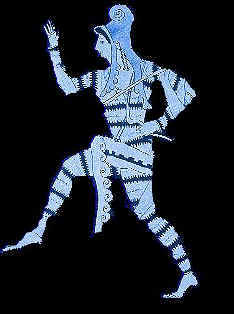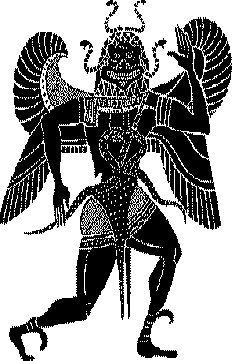 Myths of the Amazons
Myths of the Amazons Myths of the Amazons
Myths of the AmazonsThere are several myths surrounding the Amazons in Ancient Greek mythology. These myths often involve a mythic hero, a battle, and later a defeat of the Amazons. Of the three most known myths were, the account Diodorus gives of the Amazons in Atlantis, the twelve labors of Hercules, and Theseus and Panthesilia. There are many other myths about the Amazons, but the above mentioned are the main three. Click on the Myth below, following a description of the myth is an analysis of the myths possible meaning, etc.
![]()
 |
|
(Note: For the translations from Diodorus of Sicily specifically dealing with the Amazons, visit Wild Women: The Amazons - Diodorus of Sicily)
Diodorus, (340BC - ?) a scholar/historian of ancient Greece wrote of the origins of the Amazons as dating back to the ancient time of Atlantis. In his account, the Amazons lived in western Libya, the land of civilized people, and from where the gods came.According to Diodorus, the Amazon's culture and customs were the exact opposite to that of normal day Greece (and in Atlantis). It was the men who worked in the domestic sphere of life, while the women partook of politics, the art of war, and who were required to serve in the army for several years during their adolescence. Diodorus states that only after a woman had finished her time within the army was she allowed procreative liberty. When a child was born, the men took care of the children, who depending on sex were treated in differing ways. While a boy would earn a mundane and domestic existence. The girls were subject to a tradition of breast demarcation, where either the right or left breast was seared. According to Diodorus this demarcation was "For they thought that the breasts, as they might not develop at the time of maturity; for they thought that the breasts, as they stood out from the body, were no small hindrance in warfare; and in fact it is because they have been deprived of their breasts that they are called by the Greeks Amazons."
The tale of Atlantis thus continues with the queen of the Amazons Myrina, setting out to lay siege on Atlantis. The Amazons took the city of Cerne in Atlantis, and with the Atlantians bowed to their rule (with some resistance). After the Amazons took over they were expected to kill the Gorgons from the west who were constantly attacking Atlantis. The Gorgons were a group of medusa like creatures. Before the Amazons battled the Gorgons, there was an uprising in a city where half of the Amazons were killed while they slept (by their own swords), but the native peoples. Still unrelenting, the Amazons went up against the Gorgons and only half won. Eventually it took Perseus to finish off the Amazons.
The Atlantian myth is a prime example of a reverse gender, or alien other myth. In a reverse gender myth, everything which happens in a normal society or civilization, is the opposite. In Greek society women held domain over all of the domestic duties of the house, and were not allowed to participate in the art of war, politics, etc. Such reverse role myths serve several purposes within many cultures. Firstly, they reinforce the status quo but portraying how unnatural it would be if the opposite were true in a civilization. Secondly, the myth serves to reinforce the patriarchy of ancient Greece. As women are only half able to handle the Gorgons (representative's of the sublime female force, and are an absolute terror to men), it finally takes a mythic hero such as Perseus to battle the Gorgons and finish them off. This in combination with other aspects of the myth lend to the hypothesis that the myth in combination with others served to also reinforce the fact that women could not handle power, and that their role in the myth above (as warriors) was in some way unnatural.
![]()
Hercules was a mythic hero in Greek mythology, his endeavors brought him from being a mortal into the realm of immortal. Hercules, the son of Zues, and was born from a union between Zues and Alcmena (a mortal).Hercules was forced to perform twelve labors because Hera, after smiting him with a fit of insane rage, killed his wife Megara, and his children. After this act, Hercules exiled himself and sought out the Pythia (Delphian priestess), at Delphi. The oracle at Delphi instructed Hercules to spend time as a servant to Eurystheus, in Tyrins. Eurystheus sent Hercules to commit to twelve labors in order to purge/cleanse himself from the murder of his wife and children.
 |
|---|
Hercules' twelve labors were as follows:
Slay the Nemean Lion
Clay the Hydra of Lerna
Capture the Cernthis Hind
Trap the Erymanthian Boar
Clean the Augean Stables
Get rid of the man eating Stymphalian Birds
Capture the Cretan Bull
Capture the cannibalistic horses of Diomedes
Capture Hippolyte's Girdle (Hippolyte was the queen of the Amazons)
Capture the Cattle of Geyron.
Slay the Dragon which guarded the apples of Hesperides.
Capture Cerebus the three headed dog.
The capturing of Hippolyte's girdle takes on a great importance concerning the Amazons. Hippolyte possessed a golden girdle given to her by Ares (god of war), Some sources say that Hercules raped Hippolyte in order to take the girdle, but other sources say she gave it willfully. In either case, whether the Hercules took is forcefully or not, the other Amazon's retaliated against Hercules. Hercules battled with the Amazons until none were left, and within modern Greece this event served to explain why there were no Amazons in the black sea region when the Greeks arrived to the area in 650 BC (for trade mostly the actual date remains sketchy).
The twelve labors of Hercules all involve the taming, capture, cleaning (the cleaning of the Augean Stables), or slaying of wild beasts, taken in this context the labor of taking Hippolyte's girdle stands out. The myth serves not only to explain (according to the Greeks), why there were no Amazons in the Thermiscrya region of the Anatolia peninsula, but also show the unnatural or dangerous side to a woman not bound by the traditions of Ancient Greece. In a sense, a woman who was not bound by marriage or the customs of Greece was dangerous. The Amazons represented a way of life entirely the opposite of "normal" civilized Greece, and thus would pose a threat to such a mythical hero's as Hercules, Theseus, or Perseus. Similarly, the Amazons in this context represent a threat to the natural order of Greek civilization, and must be tamed or killed in response.
![]()
|
(A wounded Amazon) |
During the Trojan war Achilles found Panthesilia (also spelled Panthesilia), an Amazon. Achilles was another mythical hero in Greek myth, whose only weakness in battle was his heal (hence the term Achilles heal). In myth Achilles is represented as somewhat wild. At a very young age he disobeyed his teacher, Chiron (a centaur), becomes a general at fifteen, and lays siege to many cities through out Greece. Panthesilia alternately was a great Amazon warrior, who accidentally killed Hippolyte, but received cleansing, and thus led a legion of Amazons into combat at Troy.
The myth thus follows that Penthesilia's legion and Achilles', meet in Troy and battle one another, but when Panthesilia is struck down and killed by Achilles' takes to the custom of claiming his enemies armor. After removing his armor he openly weeps over the beauty of the now dead Panthesilia, and in some myths rapes her.
What happens after the battle with Achilles is what makes the myth largely questionable in relation to the Amazons. Of the many variations to the story, one source places her being killed by Achilles and not being raped, another places her as being raped and given a warriors funeral, and another places her as just being wounded (in which case she is tortured to death and killed without honors (the ultimate defamation of an Amazon warrior). In either of the cases above, the idea that the Amazons still held onto their femininity though they were female warriors remains constant, and the significance of the myth brings to light this fact.
Ironically, later retelling of the myth of Panthesilia offer some light into what the amazons may have meant to later civilizations, specifically during the Victorian era. Heinrich Von Kliest's play, "Panthesilia: A Tragic Drama", demonstrates the view of Amazons during the Victorian era. In his work, Panthesilia and Achilles have a masochistic relationship toward one another. Panthesilia who wants a child by Achilles joins his army, accompanied by other amazons, and is killed in battle when she becomes enamored by a suit of metal an opposing soldier wears. Within the play the Amazons are portrayed as blood thirsty man killers; berserkers in one instance, but compassionate women in the next. Through out Heinrich's work the Amazons because of their femininity are at a loss as warriors, and are therefore subject to the problems of their own biological urges, etc. Though his work did not reach great heights of popularity, it does display the general view of the Victorian era that women were of the "fairer" and "the weaker" sex to men.